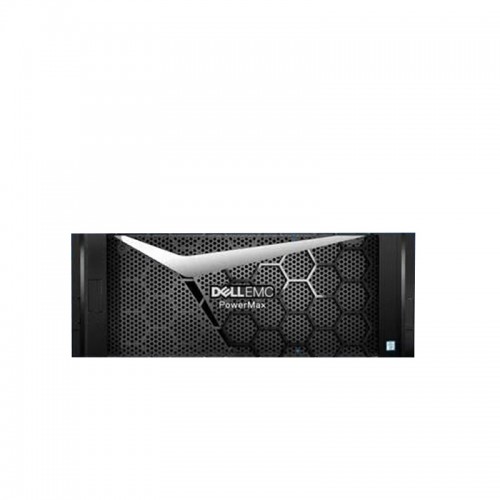- Shop
- Storage solutions
- Dell EMC PowerMax 2000
-
Overview
The Dell EMC PowerMax 2000 is an enterprise-grade all-flash storage array designed for mission-critical workloads. As the entry point into the the PowerMax family, it delivers high performance, ultra-low latency, and rich data services in a compact form factor. It supports end-to-end NVMe, Storage Class Memory (SCM), and integrated machine learning for auto-optimization. It is ideal for consolidating mixed workloads (databases, analytics, transaction processing), and supports rigorous availability, replication, and security capabilities.
With support for up to 1.2 PB (petabytes) of usable capacity and a dual-brick architecture, the PowerMax 2000 offers a balance of performance, capacity, and enterprise features in a dense footprint.
Features
- End-to-End NVMe & SCM Support
The PowerMax 2000 supports 32 Gb/s FC-NVMe host connectivity and native NVMe over PCIe drives, together with dual-port Intel® Optane™ SCM drives for even lower latency and fast I/O paths. - High Performance & Low Latency
The system is engineered for I/O response times measured in microseconds and throughput up to tens of gigabytes per second (depending on configuration). - Advanced Data Services & Efficiency
It includes inline global compression, deduplication, thin provisioning, snapshots, clones, and data reduction functionality to improve capacity utilization and reduce total cost of ownership. - Machine Learning–Driven Optimization
Built-in real-time machine learning monitors workload patterns and automates data placement to optimize performance, without added administrative overhead. - High Availability & Reliability
The architecture is designed for six nines (99.9999 %) availability, with redundant directors, cache, fabric, and failover mechanisms to support mission-critical operations. - Enterprise Replication & Disaster Recovery
The system integrates with SRDF (Symmetrix Remote Data Facility) for synchronous and asynchronous replication, enabling business continuity and disaster recovery strategies. - Security & Encryption
End-to-end efficient encryption is supported (from host to storage media), along with in-flight and at-rest encryption, while preserving data reduction capabilities. - Scalability & Consolidation
The PowerMax 2000 supports mixed workload consolidation (block, file, mainframe, IBM i) on a single array, allowing fewer silos and simpler management. - Rapid Provisioning & Automation
Storage provisioning can be completed in under 30 seconds. Integration with DevOps tools, Kubernetes, and automation frameworks simplifies operations.
Specifications
Below is a summary of key technical specifications for Dell EMC PowerMax 2000. Actual values may vary depending on chosen configuration, software package, drive types, and expansions.
Category
Specification
Architecture
Dual-brick architecture (1 to 2 bricks per system)
Maximum Usable Capacity
Up to ~1.2 PBe (petabytes) per array (with data reduction enabled)
Drive Types Supported
NVMe flash drives (2.5″) in 1.92 TB, 3.84 TB, 7.68 TB, 15.36 TB SCM drives in 750 GB, 1.5 TB
Maximum Drives
Up to 96 drives per array
Cache / Memory
Minimum raw cache: 512 GB Engine configurations support 512 GB, 1 TB, and 2 TB cache options
Front-end Host Connectivity
32 Gb/s FC / FC-NVMe 16 Gb/s FC 10 GbE (iSCSI, SRDF) 25 GbE (iSCSI, SRDF)
Redundancy & High Availability
Fully redundant directors, cache, fabric paths, power supplies, vaulting mechanisms
Power & Electrical
For one PowerBrick: ~3,099 VA (at >35 °C) combined zones For two PowerBricks: ~6,166 VA combined zones
Physical Dimensions (Per Brick / System Bay)
Height: 75 in / 190 cm Width: 24 in / 61 cm Depth: 42 in / 106.7 cm Max weight: ~620 lbs (281 kg) for one brick; up to ~1,610 lbs (730 kg) for dual-brick configuration
Operating Environment
Standard data center temperature and cooling ranges; internal vaulting to Flash
Data Services
Inline compression, inline deduplication, thin provisioning, snapshots, clones, replication (SRDF), encryption, automated optimization
Management & Automation
Web-based GUI, REST APIs, integration with DevOps / containers / orchestration frameworks
Fault Tolerance & Reliability
Designed for 99.9999 % availability, non-disruptive upgrades and expansions
Replication & DR
SRDF synchronous and asynchronous replication capabilities
- End-to-End NVMe & SCM Support


